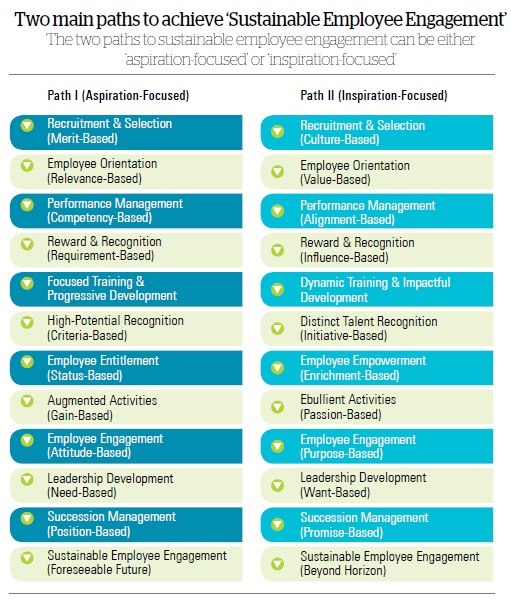Engagement uninterrupted – Achieving sustainable employee engagement

Employee Engagement is gravitating towards a more purpose-driven display of altruistic professionalism from the more recognizable affective manifestation of organizational citizenship behavior
Finding the drivers for intrinsic motivation can provide the jovial anchor for employees to align their interests with the organization and dismiss any lurking thoughts of attrition
Majority of the global businesses are going through significant changes in order to stay relevant in a digital world that thrives on disruptive innovations and is mulishly unwilling to bond with the conventional notions of management. This has profound implications for progressive organizations that are adamantly focused on retaining desired talent. The respective task is made harder by the presence of a diverse and multi-generational workforce with different aspirations and motivations. Generally, in their desperation, majority of corporate entities resort to ‘sweetening’ the Employee Value Proposition (EVP) by offering a ‘one-size-fits-all’ package without reaching out to employees for including their ‘voice’ in framing the policies/procedures/processes that are more conducive to a healthy working relationship.
Interestingly, technology seems to be a key protagonist of such ‘isolationism’ since it provides a relationship buffer in maintaining the mirage of organizational harmony by ensuring prime focus on efficiency, rather than, delving deeply into the intricacies of sound employee relationships. This is buoyed by a psychological contract that has shifted from being blindly based on solemn faith to being watchfully propped up on validated trust. Additionally, Employee Engagement is also gravitating towards a more ‘purpose-driven’ display of altruistic professionalism from the more recognizable affective manifestation of organizational citizenship behavior due to most progressive organizations requiring Employee Engagement, rather than, expecting it as a natural offshoot of an enterprising culture based upon robust values. Following are two main paths to achieving ‘Sustainable Employee Engagement’ to overcome such challenges:

PATH I (ASPIRATION-FOCUSED)
This is dutifully adopted by corporate entities that feel ‘burdened’ with the expectations of the key stakeholders and want to ensure smooth running of all operations to assure the ‘going concern’ status of their organization.
Recruitment & selection (Merit-based)
This refers to the normative practice of hiring desired talent according to clearly defined criteria that are designed to preclude any form of exclusion/discrimination and meet applicable legal regulations and corporate mandates.
Employee orientation (Relevance-based)
This refers to all the activities that are undertaken to ensure that the inducted employees are fully cognizant of key policies/procedures/processes applicable to them. It also sets the foundation for the relevant functional heads to guide their assigned staff in becoming valuable members of the team with clear understanding of the job expectations.
Performance Management (Competency-based)
This type of Performance Management is rooted in identifying, monitoring, improving and sustaining the desired competencies within the workforce. It ensures that the organization is never starved of the necessary behaviors, skills and knowledge needed to compete in an unforgiving market.
Reward & Recognition (Requirement-based)
This type of Reward & Recognition is derived from the fulfillment of certain requirements that are laid out in advance to all the key stakeholders. This can range from a conventional salary package to the integrated application of ‘total rewards’ that runs concurrently with the employee lifecycle.
Focused training & progressive development
This refers to readying and grooming of the budding talent through a targeted regimen of skills and knowledge that are deemed necessary as a result of shortcomings realized after performance appraisals or in management reviews due toany changes in the organizational functionality.
High-potential recognition (Criteria-based)
This refers to identifying the talent who have excelled in their current roles in accordance with explicitly defined parameters and are deemed suitable for leadership positions in future. They are considered the ‘prized assets’ and garner prime attention of the senior management.
Employee entitlement (Status-based)
This refers to the psychological mindset of High-Potentials as they are made aware formally or pick up hints from their supervisor/functional head of their ‘special status’ within the workforce. On one hand, it can engender positive feelings of accomplishment, gratitude, motivation, etc., while on the other, increase narcissism, class warfare with peers, privilege claims, etc.
Augmented activities (Gain-based)
This refers to the type of extrinsic motivation tools that are deployed by the senior management to tighten the ‘golden handcuffs’ on High-Potentials in order to ensure retention while negating any attempts by opportunistic competitors to wrestle them away. These can include; higher bonuses, surprise holiday privileges, free memberships, socialization with senior leaders, etc.
Employee engagement (Attitude-based)
This type of employee engagement is driven by intrinsic motivation and hard to paint as an organizational norm. Generally, it is a reflection of an individual’s inherent attributes and, quite possibly, a result of his/her own success in overcoming serious challenges and achieving significant success, for example, becoming a High-Potential, that incentivizes them to pay it forward.
Leadership development (Need-based)
This type of leadership development is initiated in accordance to the apparent demand for capable leaders to take the mantle from those exiting the organization. It is reactive in nature since the number of leaders leaving is largely known and within predictable limits.
Succession management (Position-based)
This type of succession management is done by focusing on critical leadership positions within the organizational hierarchy. Care is taken to ensure that there are no ambiguities in qualifications that need to be met to ensure a timely and suitable successor for the departing leaders.
Sustainable employee engagement (Foreseeable future)
This refers to ensuring sustainable employee engagement within the predictable business cycle by keeping the High-Potentials motivated through timely and relevant leadership development and succession management initiatives. It involves keeping a close watch over their wellbeing and being reasonably accommodative to any fluctuation in professional expectations.
PATH II (INSPIRATION-FOCUSED)
This is gladly embraced by corporate entities that are ‘invigorated’ with the expectations of the key stakeholders and strive to excel innovatively in producing the ‘delight factors’ as a distinguishing feature of their organization’s effectiveness in being a formidable competitor.
Recruitment & selection (Culture-based)
This refers to the unconventional practice of giving top priority to hiring desired talent for being a good ‘cultural fit’ with the organization, rather than, prowess in a particular function. Such an approach is contingent upon the organization’s ability to provide high quality of necessary training and development.
Employee orientation (Value-based)
This refers to exposing the inducted employees to all the core aspects that are not only relevant to them, but also, deemed to be of value for future career possibilities, cultural assimilation and professional interactions within the organization, e.g., insightful learning about aligned functional areas, meeting distinguished previous employees, etc.
Performance Management (Alignment-based)
This type of performance management is focused on the congruence between the employee, the assigned role(s) and the work environment. It is concerned with the ‘underlying’ personality in addition to the ‘observable’ person. Consequently, this requires close collaboration of the relevant supervisor(s) with the HR/Talent Management function and an in-house/retained psychologist.
Reward & Recognition (Influence-based)
This type of Reward & Recognition is focused on the level of positive influence that an employee exercises on all the determinants relating to his/her career progression, e.g., peer relationships, supervisor interactions, customer interfaces, networking prowess, etc. It goes beyond the visible confines of the KPIs and can be ascertained by using suitable analytical tools, for example, 360 degree feedback, critical incident reports, activity logs, etc.
Dynamic training & impactful development
This refers to modeling the training & development according to the individual needs and moving beyond the ‘mass model’ application of a yearly schedule. It also liberates the Training & Development function to explore viable options outside the classroom, for example, eLearning, virtual reality, mentor-guided projects, free-time for innovative experimentation, etc.
Distinct talent recognition (Initiative-based)
This refers to appreciating the distinguishing value that each employee enterprisingly demonstrates and creating an overall unrestricted ‘Knowledge, Skill, Behavior & Competency Map’ for the whole organization. It requires astute discernment from the supervisor(s) and is geared towards alleviating the simmering resentments that may arise among peers who see ‘identified’ High-Potentials as a ‘privileged class’.
Employee empowerment (Enrichment-based)
This refers to licensing the employees in taking more real-time decisions that are in congruence with the organizational values. It elevates employees from being ‘loyal abiders’ to ‘model citizens’ in the execution of their job responsibilities and creates a rich hybrid of confidence and humility while learning from successes and failures.
Ebullient activities (Passion-based)
This refers to finding the drivers for intrinsic motivation that can provide the ‘jovial anchor’ for employees to align their interests with the organization and dismiss any lurking thoughts of attrition. It requires lucid communication and insightful understanding of what galvanizes employees into productive actions, for instance, office-time allocation for personal projects, participating in social entrepreneurship, adventure retreats with senior management, etc.
Employee engagement (Purpose-based)
This type of employee engagement is a hybrid of intrinsic and extrinsic motivation and unites the employees under a core set of organizational values. It is both expected and nurtured as a key trait of being a team member. It is characterized by an unflinching focus on providing superior service with a healthy dose of ‘delight’ factors.
Leadership development (Want-based)
This type of leadership development focuses on preparing current/future leaders with the qualities that go beyond the requirements of the foreseeable future and have a high probability of being in demand in the long term with respect to the changing business landscape, for example, the ability to leverage big data to make critical business decisions, ability to integrate different mediums of technology to stay ahead of disruptive innovations, ability to interface with artificial intelligence as part of the diverse workforce, etc.
Succession management (Promise-based)
This type of succession management goes beyond the present hierarchical setup within the organization and focuses on anticipating what kind of organization needs to exist beyond the foreseeable future. Such a measure ensures that the potential successors are prepared to take on not only the conventional leadership positions, but also, embrace roles that are either nonexistent or in their infancy at the present moment with high probability of becoming the norm in the long term, e.g., Chief Innovation Officer, Chief Integration Officer, Chief Virtual Reality Officer, Chief Human & Artificial Intelligence Workforce Officer, etc.
Sustainable employee engagement (Beyond horizon)
This refers to ensuring sustainable employee engagement beyond the foreseeable future by institutionalizing insightful leadership development and succession management practices that focus on retaining the commitment of desired talent by soliciting their unquenchable zeal and unflinching imagination in achieving seamless and ceaseless innovation. Such an undertaking requires that the humanistic elements are irrevocably combined with the judicious use of technology to ensure ‘peaceful’ coexistence in order to meet unforeseen challenges without trepidation/misgivings regarding the respective alliance.
Both of the aforementioned paths lead to sustainable employee engagement, however, the second path is generally preferable as the more enduring approach for progressive organizations since it provides a stronger impetus for maintaining their competitive edge through a more refined and durable way of leveraging the synergies between luminous foresight, astute decisiveness, coalescing culture, invigorating work environment, unambiguous empowerment, seamless compliance, timely execution, impartial self-reflection and the undeterred resilience to ensure effective remedial measures.













